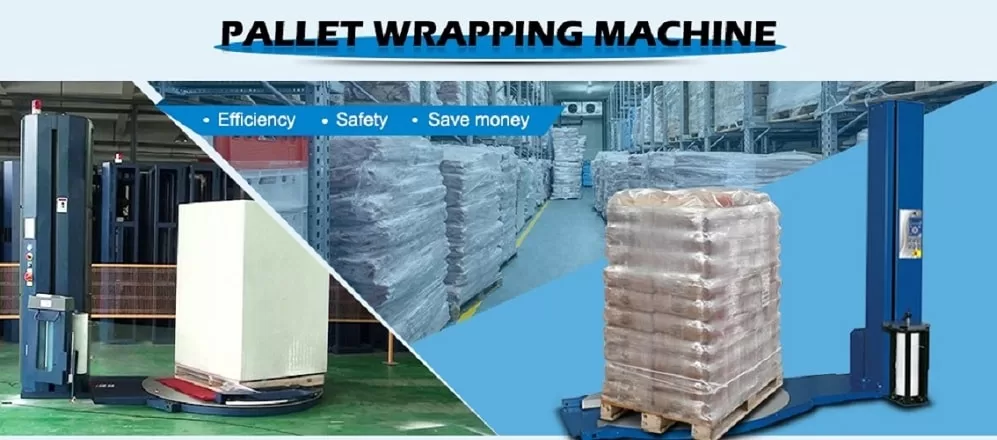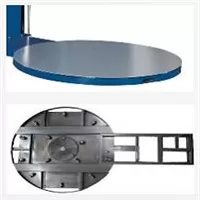Optimizing Pallet Packaging: A Guide to Automatic Turntable Wrappers with Top Sheet Dispensers
Ensuring products arrive at their destination securely and undamaged is paramount in manufacturing and logistics. Effective pallet wrapping plays a crucial role in achieving this, safeguarding goods during transit and storage. For operations requiring enhanced protection against environmental factors like dust and moisture, an Automatic Turntable Pallet Wrapping Machine equipped with a Top Sheet Covering system offers a robust and efficient solution. This guide explores the functionality, benefits, and applications of these integrated packaging systems.
Understanding the Operational Process
Automatic turntable pallet wrappers automate the stretch wrapping process, significantly improving consistency and throughput compared to manual methods. The integration of a top sheet dispenser adds a vital layer of protection. Here’s a breakdown of the typical operation:
- Pallet Loading: The palletized load is placed onto the machine's turntable, often via conveyor systems in fully automated lines.
- Top Sheet Application: Before wrapping commences, an automated mechanism dispenses a pre-sized sheet of polyethylene film over the top of the load. This sheet shields the upper surface from contaminants and moisture.
- Turntable Rotation & Film Application: The turntable begins to rotate at a controlled speed. Simultaneously, the film carriage, holding the roll of stretch film, moves vertically along a mast.
- Stretch Film Wrapping: The system applies stretch film around the load. Most modern machines feature powered pre-stretch capabilities, stretching the film before application. This optimizes film usage (reducing material costs) and ensures tighter, more secure load containment.
- Film Cut and Clamp: Once the programmed wrap cycle is complete (covering the load from bottom to top, often overlapping the top sheet), the machine automatically cuts the film and clamps it, ready for the next cycle.
- Pallet Discharge: The fully wrapped and covered pallet is then typically moved off the turntable by conveyor, completing the automated packaging process.
This integrated system, like the one available from specialized providers ([internal link placeholder - kept as per instruction 9] http://www.fhopepack.com/Stretch_wrapping_machine.html), streamlines operations by combining two essential packaging steps into one automated sequence.

Key Features and Operational Advantages
Investing in an automatic turntable wrapper with top sheet functionality provides several operational benefits:
- Enhanced Product Protection: The primary advantage is superior protection. The stretch wrap secures the load, while the top sheet acts as a barrier against dust, dirt, and moisture ingress, crucial for sensitive products.
- Improved Load Stability: Consistent application of optimally stretched film creates a stable, unitized load, reducing the risk of product shifting or collapse during handling and transportation. Learn more about load containment principles from industry resources like the Material Handling Institute (MHI) [Placeholder for relevant external link].
- Increased Throughput and Efficiency: Automation significantly speeds up the wrapping process compared to manual or semi-automatic methods, boosting overall packaging line productivity.
- Optimized Film Consumption: Powered pre-stretch systems can yield significant film savings (often 150-300% stretch), lowering material costs and environmental impact per pallet wrapped.
- Reduced Labor Requirements: Automating the wrapping and top sheet application frees up personnel for other value-added tasks.
- Consistent Wrapping Quality: Automated controls ensure every pallet is wrapped according to pre-set parameters, eliminating inconsistencies common with manual wrapping.
- Improved Safety: Automating the process reduces the need for manual handling around rotating machinery and heavy loads.
Typical Technical Specifications
While specific configurations vary between manufacturers and models, typical parameters for an automatic turntable pallet wrapper with top sheet covering include:
- Machine Type: Fully Automatic Turntable Stretch Wrapper with Integrated Top Sheet Dispenser
- Pallet Size Compatibility: Commonly handles standard pallet sizes up to 1200mm x 1200mm (or 48" x 48"), with options for larger dimensions.
- Maximum Wrapping Height: Typically up to 2400mm (approx. 94"), adjustable based on load requirements.
- Turntable Speed: Variable, often up to 12-15 RPM, adjustable for load stability.
- Film Carriage Speed: Independently adjustable (up/down) to control film overlap.
- Film Pre-Stretch: Powered systems, often adjustable up to 250% or 300%.
- Top Sheet Material: Polyethylene (PE) film roll.
- Standard Film Thickness: Compatible with 17-35 micron stretch films.
- Turntable Load Capacity: Commonly up to 2000kg (approx. 4400 lbs).
- Control System: PLC (Programmable Logic Controller) with HMI (Human-Machine Interface) for parameter setting and diagnostics.
- Power Requirements: Varies by region and configuration (e.g., 480V/3Ph/60Hz or 230V/1Ph/50Hz).
- Approximate Machine Footprint: Typically around 4000mm x 2500mm (L x W), plus safety fencing and conveyor integration space.
Note: The parameters listed are representative. Always refer to manufacturer specifications for the exact details of a particular machine model.

Industrial Applications
The combination of secure wrapping and top protection makes these machines invaluable across various sectors:
- Food and Beverage: Essential for maintaining hygiene standards. Protects packaged goods (like shrink-wrapped trays, bags, boxes) from dust, warehouse debris, and moisture during storage and transit, preserving product integrity.
- Pharmaceuticals and Chemicals: Provides critical protection against contamination and environmental exposure for sensitive or regulated products. Ensures packaging integrity for compliance and safety.
- Warehousing and Distribution: Increases efficiency in high-volume logistics centers. Ensures consumer goods arrive clean and undamaged, improving customer satisfaction and reducing returns due to packaging failure.
- Building Materials: Protects bagged goods (cement, sand, tile adhesive), insulation, or finished components from weather and site conditions, especially if temporary outdoor storage is involved.
- Electronics: Safeguards sensitive electronic components and finished goods from dust and static discharge (when used with appropriate anti-static film).

pallet Integration and Implementation Considerations
Successfully integrating an automatic wrapping system requires careful planning:
- Layout and Space: Ensure sufficient floor space for the machine, safety guarding, and associated infeed/outfeed conveyors.
- Conveyor Integration: Plan for seamless connection with existing or new conveyor systems for automated pallet transfer.
- Throughput Matching: Select a machine with wrapping speeds compatible with upstream and downstream processes.
- Film Selection: Choose the appropriate type, gauge, and pre-stretch level of film for the specific loads being wrapped. Consult film suppliers for guidance [Placeholder for external link to film technology resource].
- Maintenance: Factor in routine preventive maintenance schedules to ensure long-term reliability.
- Operator Training: Provide thorough training on machine operation, safety procedures, and basic troubleshooting.
By automating both the stretch wrapping and top sheet application process, these machines offer a significant upgrade in packaging efficiency, product protection, and load security, making them a valuable asset in modern manufacturing and distribution environments.
